Karnataka
Introduction
Music and dance have always been considered to be two of the finest forms of expression, combining artistry and refinement in a way which can be rarely portrayed by any other form of art. Knowing the importance of the arts, it is hardly surprising that a culture which has a history and heritage as rich as Karnataka's will also be one of the richest store houses of the arts. Thus, the various performing arts of Karnataka are by themselves one of the greatest tourist attractions of Karnataka and a definite must-see while on a tour to Karnataka.
Music in Karnāṭaka
Music has always been regarded as one of the finest expressions of human emotions. It is used for celebrations as well as a symbol of mourning or for loss. Almost all the civilizations have their own form of music which can claim to have roots deep in the culture and heritage of the land. Thus, it is hardly surprising that a civilization whose origin dates back to as early as the culture of Karnāṭaka does will also be one of the richest store houses of one of the most frequently used forms of cultural expression’ music. Karnāṭaka is generally regarded to be the place of origin of Karnātic Music, one of the most acclaimed expressions of classical music in the world.
- Karnātic Music
The kingdoms of Vijayanagara and Thanjāvūr were the main areas which looked after the promotion of this form of music while the royal families of the kingdoms were regarded as the patrons of Karnātic Music. The emergence of the Haridhāsa movement in the 14th century gave an impetus to the Karnātic music. Among the Haridhāsas, Purandhara Dhāsa played a pioneering role in laying the foundation of Karnātic music. Known as the Pithāmaha of Karnātic music, Purandhara Dhāsa composed around 475,000 compositions in Kannada.
Today Karnātic Music has become such an integral part of the cultural outlook of Karnāṭaka that a tour to Karnāṭaka is considered to be incomplete without a performance of Karnātic Music.
- Hindusthāni Music
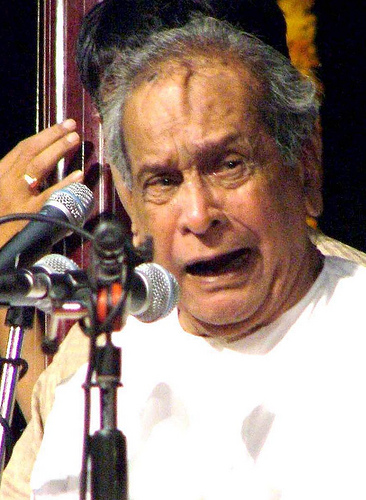
- Folk Music
Music of Karnāṭaka also encompasses a great variety of folk music. The folk music forms of Karnāṭaka are an integral part of the rural life and possess the distinctive characteristics of the regions where they belong.
Dances of Karnāṭaka
One of the most important genres where the influence of Karnāṭaka has shaped the cultural outlook of India is the several dance forms which have their origin in Karnāṭaka. The dances of Karnāṭaka are not just expressions of art, but are in themselves an expression of the cultural history of the state as well.
The main dances of Karnāṭaka include several variations of folk dances as well as some of the most important forms classical dances in India.
Classical Dances
Classical forms of dance include forms like the Bharatanātyam, which is perhaps best symbolized by its Mysore form. The other forms of the classical dances popular in Karnāṭaka include Kūchipūḍi and Kathak.
- Bharathanātyam in Karnāṭaka
Bharathanātyam in Karnāṭaka enjoys great popularity. Bharathanātyam in Karnāṭaka was practiced from as early as the 4th century AD. The royal courts of Karnāṭaka, particularly the Chāḷukyas patronized the dance form extensively. The Vijayanagara empire encouraged the growth of Bharathanātyam at Karnāṭaka. Later on, Mysore became the most important seat in developing the styles of Bharathanātyam of Karnāṭaka. The name of Jaṭṭi Thāyamma and K. Venkaṭalakṣhamma are integrally linked to the growth of Bharathanātyam in Karnāṭaka. Although transmitted on a hereditary basis, at present various art schools and academies work tirelessly to promote and educate interested men and women in the practice and performance of this ancient and highly popular classical dance form of India. Bharathanātyam dance is being taken to great heights by practicing artists who teach and perform around Bangalore and various other cities of the state.
- Kūchipūḍi in Karnāṭaka
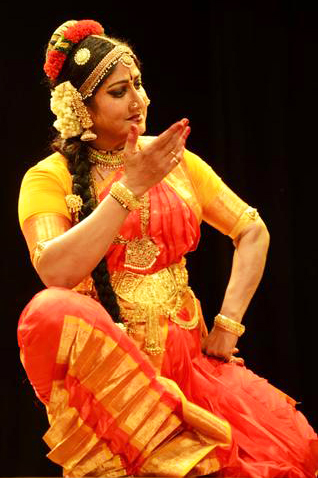
Kūchipūḍi in Karnāṭaka has enjoyed great popularity right from the ancient days. Karnāṭaka's Kūchipūḍi shares the appreciation and tradition of the dance form which essentially belongs to Andhra Pradesh. The temple sculptures of many temples of Karnāṭaka attest to this fact. Even now, Kūchipūḍi features prominently in various religious as well as secular programs across the state. Many schools and academies devoted to art and cultural studies presently feature Kūchipūḍi as an integral part of their discipline.
Folk Dances of Karnāṭaka
There are several ritualistic dances in Karnāṭaka which include forms like Kuṇitha which is basically a popular dance of Karnāṭaka in accompaniment to music. The demands of this dance include a synchronized movement of the dancers to the accompaniment of drum beats.
- Kuṇitha - A ritual dance
The ritualistic dances of Karnāṭaka are known as "Kuṇitha". folk dances of Karnāṭaka include forms like Dhevara Thaṭṭe Kuṇitha, Yellammana Kuṇitha, Suggi Kuṇitha.
Narrative performing arts of North Karnāṭaka
- Dollu Kuṇitha
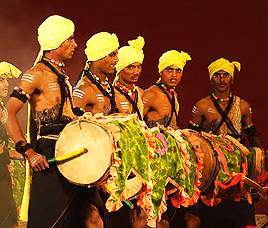
This is a group dance that is named after the Dollu - the percussion instrument used in the dance. It is performed by the men folk of the Kuruba community of the North Karnāṭaka area. The group consists of 16 dancers who each wear the drum and beat it to different rhythms while also dancing. The beat is controlled and directed by a leader with cymbals, positioned in the center. Slow and fast rhythms alternate and group weaves varied patterns.
The costumes are simple. The upper part of the body is usually left bare while a black sheet-rug is tied on the lower body over the ` dhothi ' or sarong.
A troupe led by K. S. Haridas Bhat also toured the USSR in 1987, giving performances at Moscow , Leningrad , Vibrog Archangel, Pskov, Murmansk, Tashkent and Novograd.
- Karaḍimajal
This is a popular folk orchestra of the north Karnāṭaka region. It is performed during various auspicious occasions and in processions. The Karaḍi or Karaḍe is the percussion instrument that is used in the orchestra. It is a palm sized cymbal that produces metallic sounds, while the Śhehnāi is used to produce the melody.
- Jaggalige Kunita
This is a folk art of the Hubbaḷḷi Dhārwaḍ region, particularly of the Byahaṭṭi village. It is performed on occasions such as Yugādhi and Holi . Jaggalige is essentially a percussion instrument made of a bullock cart wheel with buffalo hides wrapped around. The village folk roll out the giant instruments and march in procession. The entire performance is directed by a chief choreographer who himself uses a much smaller percussion instrument called the kanihaligi, made of clay and covered with calf hide. The performance usually involves a group of about 15 people.
- Gondhaligara Āṭa
It is performed mostly in village shrines dedicated to the Mother Goddess. The art is mostly practiced by the Gangemata community. The dance is characterized by the dancers wearing elaborate masks painted in different colours. The colour of the mask is also indicative of the nature of the deity. A benevolent deity is represented by a red mask while a yellow or black mask suggests the opposite. There are many types of somas or masks, which differ from region to region.
Narrative performing arts of South Karnāṭaka
- Nāgamaṇḍala
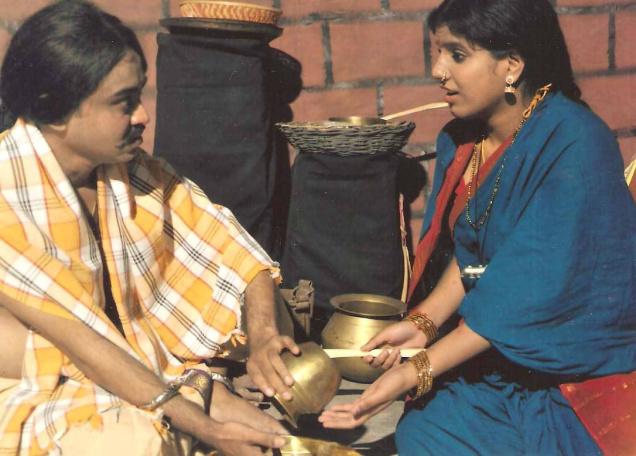
- Somana Kuṇitha
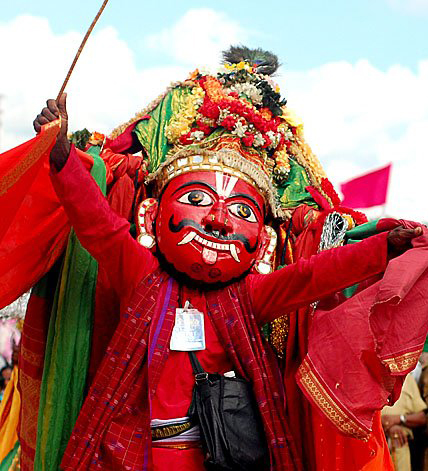
On the ceremonial day, offerings of blood of animals are made to the spirits. The masks are made of the 'Indian red tree' (Pterocarpus Santalinus Linn). The other props include a cane or stick and peacock feathers. A mini headgear containing colourful flowers, neem leaves and colourful pieces of cloth is also worn. The music is provided by the Dūnu(percussion), Mauri(wind pipe) and the Sadde(a windpipe to keep the śhruti). The dancer starts his dance from the temple of the Goddess and proceeds in a trance like state singing in praise of the spirit. An offering of the blood of a fowl or chicken is sometimes made to propitiate the Goddess.
- Bīsu Kamsāle or Kamsāle Nruthya
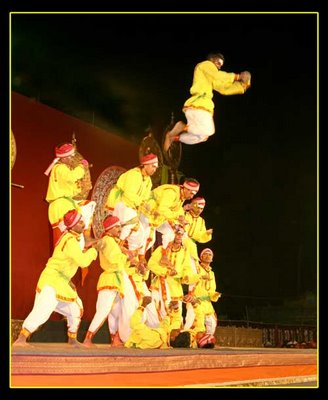
The Kamsale nrithya is closely connected to a tradition of Male Mahadeśhwara or Lord Śhiva worshipped by the hālu kuruba community. Most of the dancers are also drawn from this community. The dance is performed to rhythmic and melodious music that is sung in praise of Lord Mahadeśhwara or Lord Śhiva . The dance is a part of a 'dīkṣhā', or oath and is taught by the teacher or a spiritual leader.
This art-form was showcased prominently in Kannada movies like Janumadha jodi and Jogi where the protagonist is a kamsale dancer.
Some more Folk dances
- Gorava Dance (Goravara kuṇitha)
This is a folk dance of Goravas or the Śhiva cult that is popular in both Mysore and North Karnāṭaka regions. While in North Karnāṭaka, the Goravas worship Mylāra linga as their deity, in Mysore region, they worship Mudukuthore mallikārjuna. They hail from the Hālumatha Kuruba Gauḍa community.
In the Mysore region, the costume consists of a black and white woolen rug, a fur cap (fur from black bear) and the ḍamaru and the pillangovi(flute) are the instruments used. Sometimes a small bronze bell called pārighhanṭe is also used. The costume in the northern regions varies and the dancers wear a costume of a black woolen rug with a black coat and white dhothi.
The dance consists of trance like movements with no fixed choreography. The Gorava also anoints his forehead with yellow powder and gives Prasādha to the devotees. .
Performances are usually by a group of 10 or 11 members.
- Gāruḍi Gombe
Gāruḍi Gombe is a folk dance prevalent in Karnāṭaka . Dancers adorn themselves with giant doll-suits made of bamboo sticks. The term Gāruḍi Gombe means magical-doll in the native language, Kannada . This dance is performed during major festivals and also in the procession held during the festivities of the Mysore Dasarā. This dance is also known as Thaṭṭirāya in the coastal districts of Karnāṭaka . The term Thaṭṭirāya means a person carrying a doll made of bamboo sticks.
- Joḍu Haligi
The Joḍu Haligi is essentially a performance using two percussion instruments. The Haligi is circular in shape and is made of buffalo hide. The artists use a short stick to produce rhythms of exceptional energy and power. This is also accompanied by rhythmic movements and exaggerated expressions in sync with the high energy rhythms produced. Usually 2-3 artists are involved in the performance.
Dances of the Koḍavas
The Koḍavas are a unique martial race, different in customs, traditions and religion from the surrounding populace.
- Huṭṭari Dance
This is the annual harvest dance of the Koḍavas . The men, dressed in traditional Koḍava costumes with the decorative knife, perform this slow moving dance to background music. The dance is performed to rhythmic tunes provided by wind instruments and percussion. The dance includes certain martial movements that represent some of the techniques used by the Koḍavas in warfare.
- Bolakāṭa
This is performed by the Koḍava men in front of an oil lamp in an open field. The men hold the chavari(Yak fur) in one hand and the Koḍava short sword "Oḍi-katthi" in the other while performing this dance. Many regional variations of this dance exist. Sometimes performers dance only with the chavari without the use of the short sword. When the Oḍi-katthi is also used, it is called katthiyāṭa. The dūdi, an hourglass shaped drum is used to provide the rhythm for the dance.
- Ummaṭṭāṭa
This is performed by the Koḍava womenfolk. The women wear the traditional Koḍava dress complete with jewelry, adorn the forehead with kumkuma and in a swinging rhythm, dance in a circle, brass cymbals in hand. One woman stands at the center holding a pot full of water to represent Kāveri thāyi or Mother Kāveri, which the Koḍavas worship as their prime deity.
- Kombāṭa
While the Bolakāṭa and the Ummaṭṭāṭa are of a celebratory and festive nature, the Kombāṭa is a dance performed with religious sentiments. It is traditionally performed in temple premises, but, in recent years, it is also performed in other places. This is a dance performed by the Koḍava men and deer horns are used as a prop, representing the horns of the Kruṣhṇamruga, a spotted deer in Koḍava legend.
Dance Drama
The various dance dramas of Karnāṭaka are also important forms of the dances of Karnāṭaka.
- Yakṣhagāna
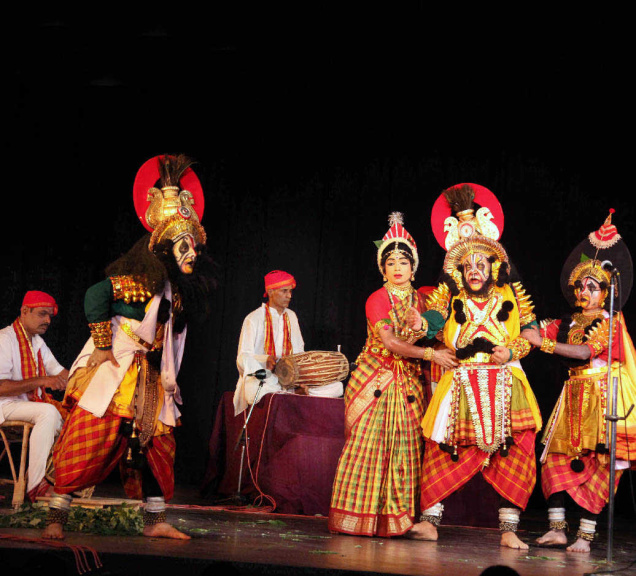
This unique dance form is a perfect blend of dance, music, songs, scholarly dialogues and colorful costumes. Yakṣhagāna mesmerizes each and everyone in the audience with its enchanting music and colorful performances.
The word Yakṣhagāna literally means celestial music. This dance drama is also performed throughout the night, usually after the winter crop has been reaped.
- Kriṣhṇa Pārijātha
Kriṣhṇa Pārijātha is a popular folk theater art form of North Karnāṭaka. It is an amalgamation of Yakṣhagāna and Bayalāta , portraying stories or incidents from the great epic Mahābhāratha .
Bibliography:
http://en.wikipedia.org/wiki/Folk_arts_of_Karnataka
http://www.udupipages.com/art-culture/folk-arts-dance-karnataka.php
http://www.indianholiday.com/karnataka/arts-and-crafts/performing-arts-of-karnataka/
http://www.indianetzone.com/22/art_forms_art_culture_karnataka.htm
http://www.shubhyatra.com/karnataka/music-dance.html
http://www.bharatonline.com/karnataka/music.html














